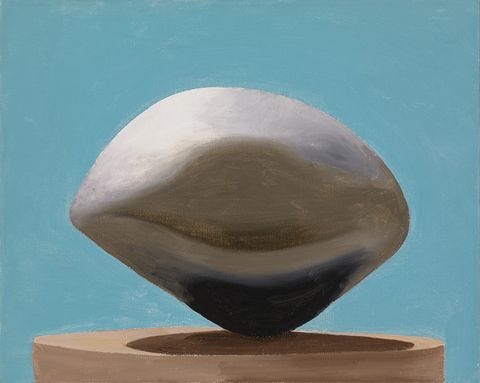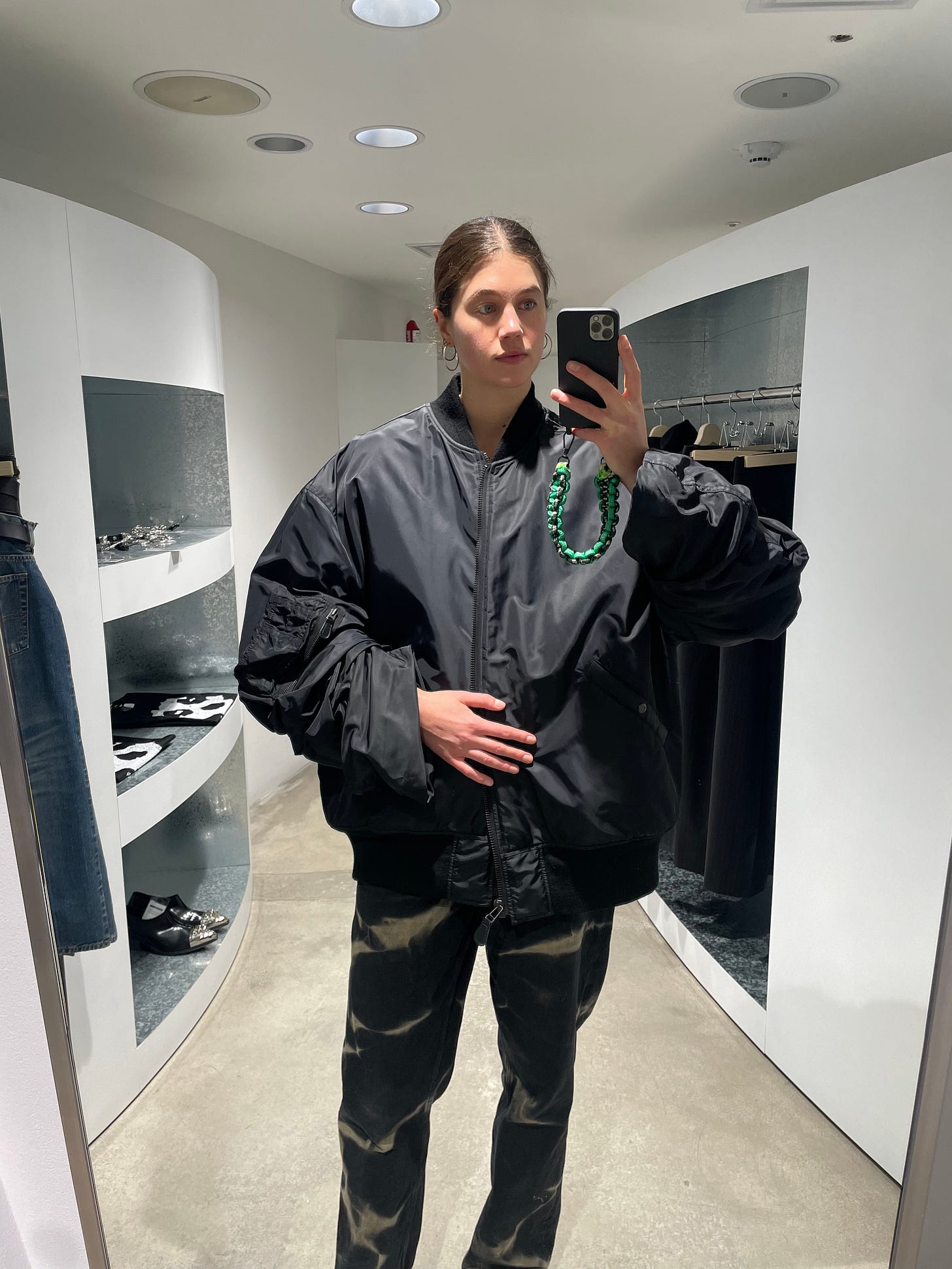A Thread about finding Japanese style in Santa Fe
Georgia O’Keeffe, visvim and Comme des Garçons
Last week, I wrote about my delusional trip to Japan. What I thought was a retrospective travelogue turned out to be a kind of prophecy.
To recap, earlier this month I spent three weeks exploring Japan and South Korea. In Japan, I visited all the fashion destinations I could find - from department stores to niche boutiques and vintage archives. To complement my travels, I also read W. David Marx’s book ‘Ametora’ while I was there.
The book is about the sartorial exchange between Japan and the USA, and it made a huge impression on me, opening my eyes to the relationship between the two nations and their approach to style.
After the trip, I was intending to return home to London, but a surprise invitation meant I flew to New Mexico instead. There, 9,500 km away, I was amazed to find countless reminders of my time in Japan.
[Housekeeping: This story might cut off in your inbox. Hit “View in browser” or “View entire message” to see the whole thing. Or read it in the Substack App.]
Georgia on my mind
I’ve always loved the artist Georgia O’Keeffe, and not just because we share a name. I also admire her work, her independent spirit, and her impeccable sense of style.
In the summer of 1929, O’Keeffe visited New Mexico for the first time. She fell in love with the landscape, and began spending her summers there. In 1949, three years after her husband Alfred Stieglitz’s death, she moved there full time. She was 62.
New Mexico marked a change in direction for O’Keeffe’s work. A woman ahead of her time, both socially and stylistically, she was known for taking long walks alone in the desert, collecting bones and skulls, which appeared frequently in her paintings. Her abstract forms were often bathed in harsh desert light, or set against an unrelenting blue sky.
On my first day in Santa Fe, I visited her eponymous museum, where I got to see some of her wardrobe up close. Like many great artists, O’Keeffe has unintentionally become a style icon. She loved clothes, but dressed for practicality, favouring mens tailoring, monochrome colours and fuss-free silhouettes - pieces that enabled her to go about her life as an independent, thinking woman. At a time when most women were encouraged to tend to the home and look shapely for their husbands, this approach was pretty avant garde.
At the museum, I saw a collection of her shift dresses, and the instantly recognizable black wrap dress with the suede and silver belt - the outfit she was photographed in the most. The dress was made by her friend in Santa Fe, a fellow artist called Carol Sarkisian. The belt was made by a Mexican silversmith, Héctor Aguilar, and was one of her favourite accessories.
There was also an apron (worn in the photo of her cooking above), which was stitched together from two scraps of denim, and a black ‘haori’ jacket which she bought in Kyoto. Annoyingly, I managed to miss her famous ‘OK’ pin, made for her by the sculptor Alexander Calder - not sure if it was there.
Both Calder and O’Keeffe shared a deep appreciation of Japanese culture. In her formative years, she had studied under artist Alfred Dow, who taught her the principles of Japanese design and composition. In the museum, I saw a number of abstract paintings directly inspired by calligraphy strokes.
Japan also had a big impact on O’Keeffe’s style. She owned many kimonos, favouring their elegant simplicity and wraparound shape. Even the denim apron seems to nod to Japan - a fabric which defines so much of the cultural exchange that W. David Marx covers in ‘Ametora’.

Ametora in action
The name of the book, ‘Ametora’ comes from the term ‘American traditional’. “It generally means American East Coast, classic, elite clothing. It’s a combination of Ivy style as well as British items like fisherman's sweaters,” explained Marx in an interview with GQ. But the scope of America’s influence on Japan means that the category has expanded far beyond its Ivy League roots. “Now things like hip-hop style and California surfer style are also in some way traditional American style.”
To massively paraphrase the book - Ametora tracks the following cycle: Japan revered American style in the postwar period, and sought to imitate it. This led to the mass importation of trends from the USA, as well as a huge quantity of vintage and deadstock clothing. A strong economy, a refreshed sense of national pride and a vast inventory of American fashion led Japanese designers to start creating a new type of American-inspired style. But instead of copying the USA like they had before, they invented something uniquely Japanese, surpassing the innovation and craftsmanship of the original.
Soon, the cycle of influence was reversed, and America began buying into Japan’s expert manufacturing (denim), new brands (eg. BAPE) and copying their marketing models (the scarcity-led hype/ drop model was invented by Japanese streetwear brands). There is a proverb that fits perfectly here: 青は藍より出でて藍より青し, which loosely translates to ‘blue dye comes from indigo, but is bluer than indigo’; a metaphor for when the student becomes the master.
One brand that sprung from this cycle of Ametora was visvim, the revered folkwear label founded by Hiroki Nakamura in 2001. As a young man, Nakamura travelled extensively in northern Alaska and rural America. There, he learned the customs of multiple indigenous groups and developed a love of the landscape and lifestyles of these places. After a stint working for Burton snowboards in Japan, he decided to distil these inspirations into his own brand, and visvim was born.
These days, visvim is widely regarded as one of the world’s most cherished artisan fashion brands, known for their ’future vintage’ aesthetic, which is achieved through processes like dyeing jackets in fields of mineral mud. I first heard of visvim during my time working at Browns Fashion, where the menswear buyers would talk about it in hushed, reverential tones.
As a student of indigenous textiles and craft, New Mexico epitomises the essence of Nakamura’s work. In 2017, he opened his first North American store in Santa Fe, which is where I found myself on Wednesday last week, experiencing Ametora in real time.
The boutique is located in a small converted house near Santa Fe’s central plaza. Inside, American-inspired clothing (both mens and womens) is presented side by side with Japanese objects and artefacts - a painted screen, Geta sandals and porcelain ceramics.
The store manager, a painter called Josedgardo Granados, was warm and welcoming. He told me that a lot of hardcore visvim fans would make a pilgrimage to Santa Fe from LA, just to experience the store in person (even though one opened in LA a year later, in 2018.)
Precious artefacts
The store also contains textiles from the nearby Shiprock gallery, which Granados recommended we visit. It’s home to a vast array of archival Navajo textiles, sculptures and jewellery - one room was piled high with fabrics, some dating back as far as the 1800s. Standing in the middle of the room, surrounded by handmade pieces of history, can only be described as a quasi religious experience.
The owner, Jed Foutz, is a close friend of Nakamura’s, sharing his passion for indigenous artefacts. “I’m so inspired by Navajo — especially old Navajo — artisan work like blankets. The sense of beauty they have, it just reminds me of the things made in the Edo period in Japan,” explained Nakamura in a conversation with Foutz. Foutz also has his own relationship with Japan - as a young man, he spent two years working as a missionary there.
After Shiprock, I headed to a sprawling vintage store nearby called Double Take, where a series of connecting rooms contained everything from classic thrift shop fare, to a huge array of cowboy boots in every size and style. They also had a wide range of designer pieces - including one that caught my eye. Squeezed onto a rail, I spotted a cropped Comme des Garcons tuxedo jacket. Its elbows were sliced open to reveal a fistful of black gauze, which also extended from the cuffs.
Unfortunately for me, the staff were no fools (plus, we know how bad I am at shopping). As I’d learned, in Santa Fe, they know the value of Japanese style, so the jacket was priced accordingly. I left empty handed, bemused at how my trip to Japan seemed to be following me around.

In next week’s newsletter, I’ll tell you about what I was doing in Santa Fe, and some more coincidences I encountered along the way!
Subscribe for more Threads of Conversation, listen to the podcast on Apple Podcasts or Spotify, and follow along on Instagram and TikTok.
Threads of the week
This is me in the Comme des Garçons store in Seoul, falling head over heels in love with a Junya Watanabe bomber jacket. The ruched sleeve detail! I’m praying for a Black Friday miracle. Worn with my Dries van Noten jeans, which I got secondhand on Depop.
Loose Threads
I finally read that New York magazine cover story about the state of media. Ironically (or maybe aptly) I read it in print. The quotes below stood out, from the section about billionaire media moguls.
“Media properties are no longer very good businesses, which means they often attract the interest of a different kind of rich person - either charitable or, possibly, delusional”
“[People] think people much richer than them stop caring about money. Actually, that’s not the case. It’s people who are much richer than them who care obsessively about money.”
Also Imran Ahmed throwing shade on digital covers - “whatever that means, right?” I agree! It makes the talent look bad, like they didn’t quite merit a real cover so instead the magazine invented a halfway house. Also, a friend in tech told me that the word ‘digital’ is considered dated these days.
Haley Nahman’s advice on personal style has Georgia O’Keeffe flavour.
I’m currently reading this book and it’s fascinating.
Start your own Thread
Share your thoughts in the comments, and/or let me know what you want to hear about in future! And if you enjoyed this edition, why not forward it to a friend?













Reading while on a trip to New Mexico! Gorgeous writing, I'll be taking all your recommendations.